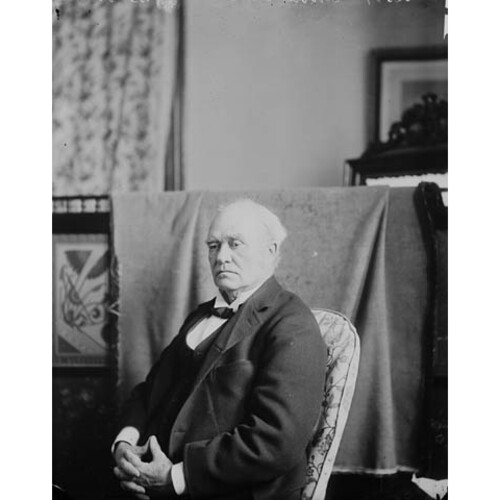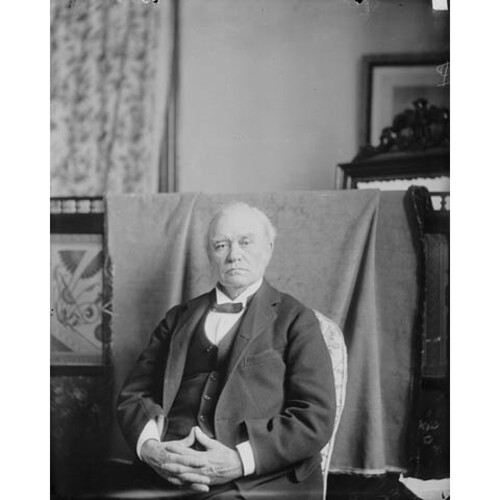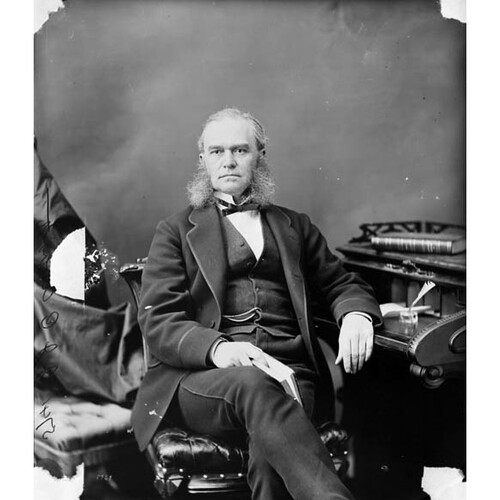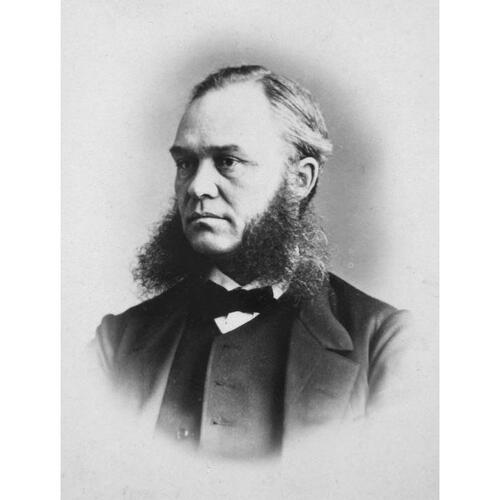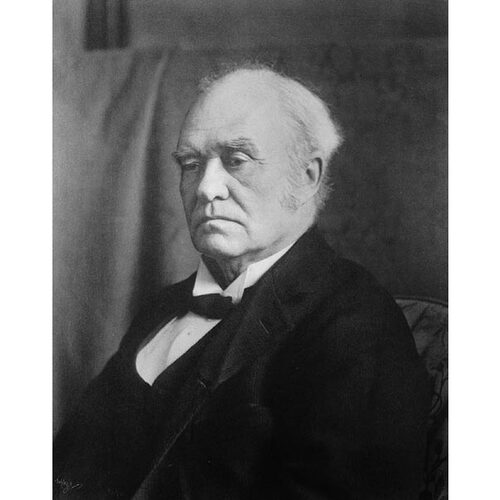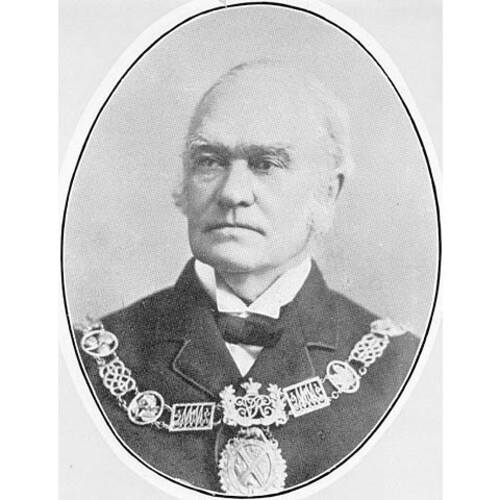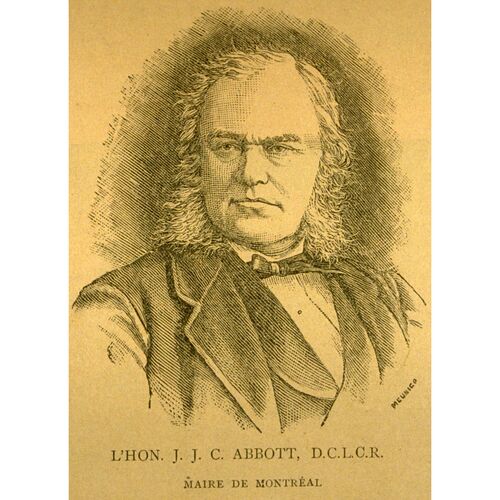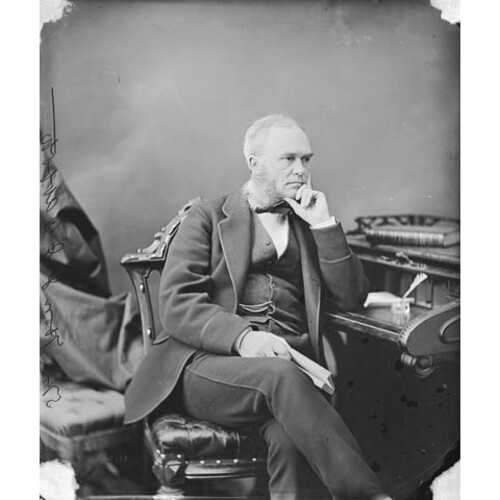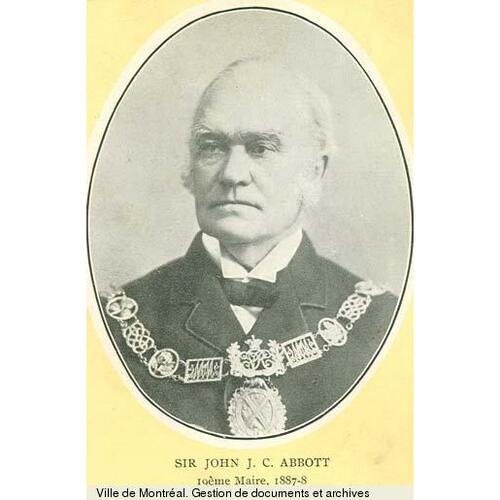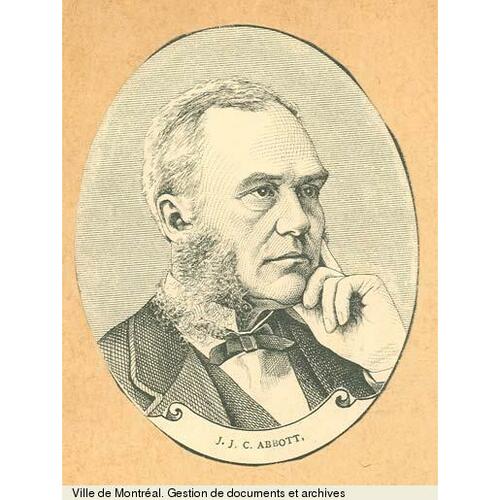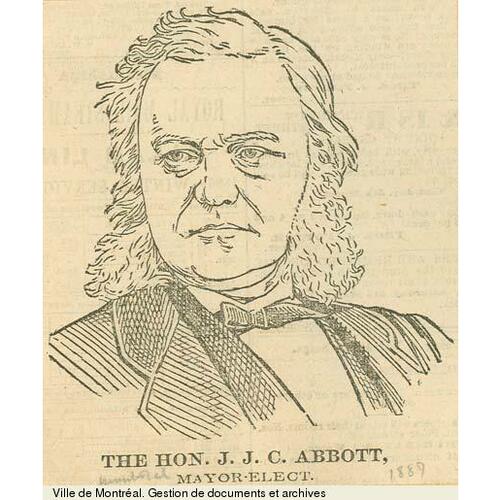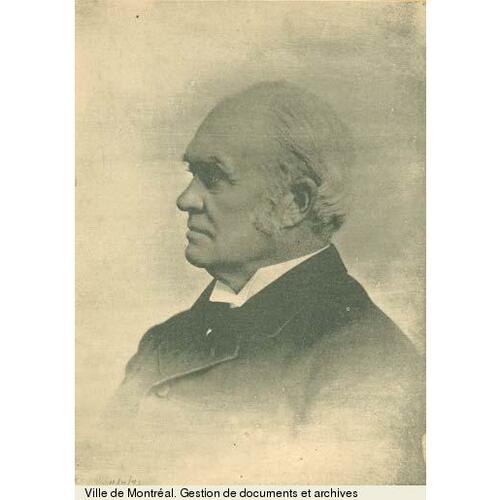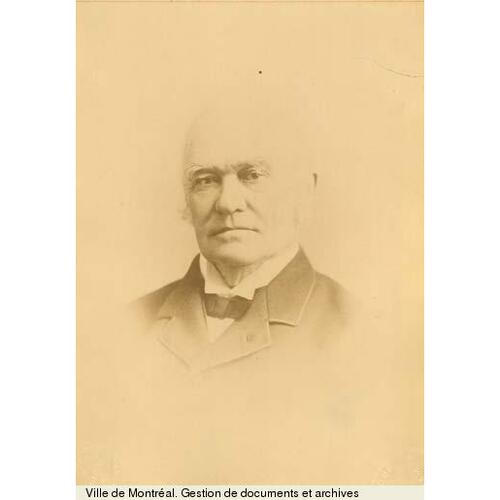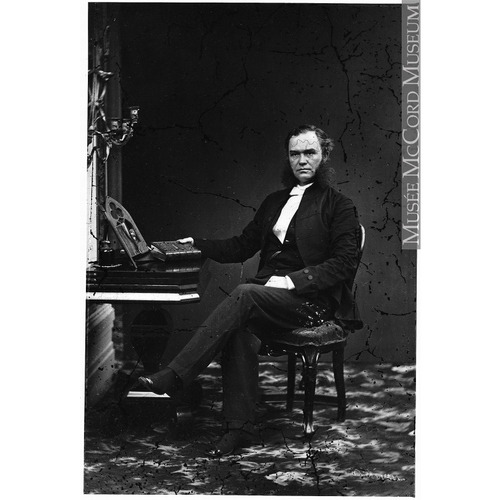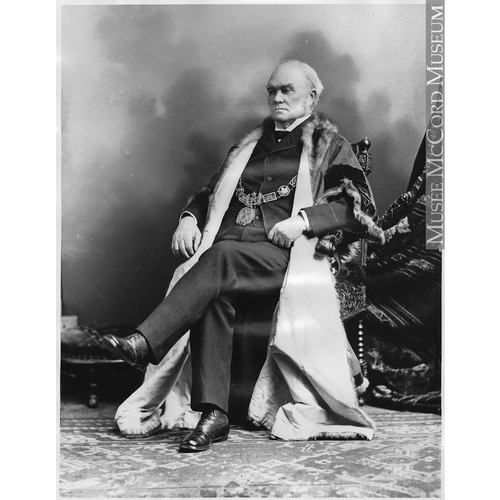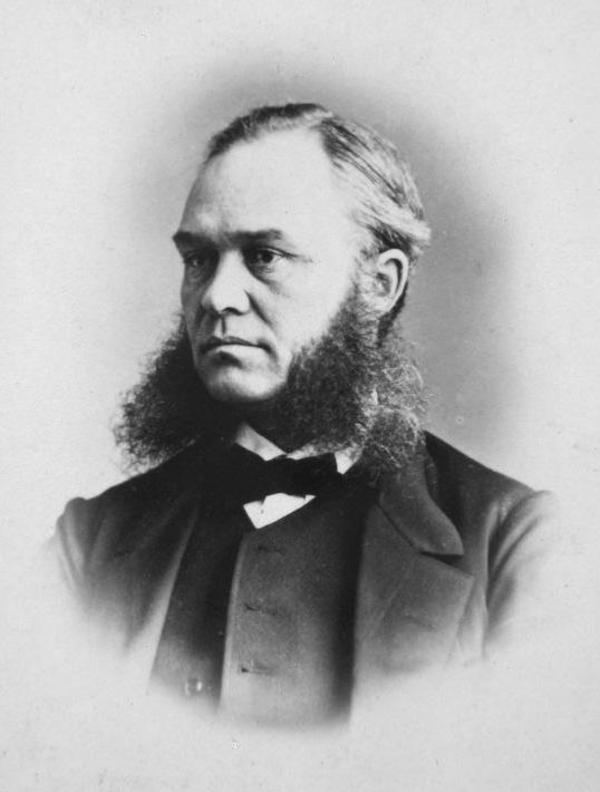
Source: Courtesy of Wikimedia Commons
ABBOTT, Sir JOHN JOSEPH CALDWELL, lawyer, businessman, educator, politician, militia officer, and gentleman farmer; b. 12 March 1821 in St Andrews (Saint-André-Est, Que.), eldest son of the Reverend Joseph Abbott* and Harriet Bradford; m. 26 July 1849 Mary Martha Bethune, daughter of the Reverend John Bethune*, and they had four sons and four daughters; d. 30 Oct. 1893 in Montreal.
John Joseph Caldwell Abbott was the son of an ambitious, English-born Church of England missionary who believed in the ascendancy of the English in British North America. Abbott’s early years were spent at various rural Anglican missions in Lower Canada, where his father was employed by the Society for the Propagation of the Gospel. A voracious reader, he was educated in his father’s well-stocked library and under his exacting tutelage. He may also have spent some time at the school in Grenville which his father had helped establish.
His secondary education completed, he began work at age 17 with A. Laurie and Company, a Montreal wholesale and retail dry-goods firm. He did everything from selling cloth to packing apples. Within a few months, however, illness obliged him to return home. Upon his recovery he secured a position with a wholesale firm in Gananoque, Upper Canada, where he learned bookkeeping and accounting. In 1843 he went back to Montreal to study at McGill College. At the same time he read law with William Collis Meredith and Strachan Bethune (his future brother-in-law), and from 1846 with Christopher Dunkin* as well. He took lessons to perfect his “fine tenor” voice, sang in and directed the six-person choir at Christ Church, and assisted his father, who was bursar of McGill, with the college’s accounts. Although a visitor’s report for 1844 found their bookkeeping irregular and incorrect, Abbott was appointed deputy registrar and secretary to the bursar in 1845, protected from reprimand by his family’s close friendship with the acting principal, Bethune, whose daughter Mary Martha he later married.
On his admission to the bar on 25 Oct. 1847 he entered into partnership with William Badgley*, professor of law at McGill, and he succeeded to Badgley’s lucrative law practice when his partner was appointed to the bench in 1855. Through Badgley’s good offices he began teaching at McGill in 1853 as a lecturer. The following year he received a bcl from McGill, and in 1867 he would obtain a dcl, a degree available without examination to any graduate 12 years after his receipt of a bcl. In 1855 he succeeded Badgley as professor of commercial and criminal law and as dean of the faculty, a prestigious but not onerous position, given the small number of students, the limited formal teaching (most of the training took place in the professors’ law offices), and the nominal administrative duties; the deanship provided an annual stipend of £500 and a share of student fees. Although Abbott retained the title of dean until 1880, he had ceased teaching and relinquished his administrative responsibilities by 1876, when William Warren Hastings Kerr became acting dean. Upon Abbott’s formal retirement, McGill named him emeritus professor in the faculty of law, and in 1881 it appointed him to the board of governors of the Royal Institution for the Advancement of Learning. After a lengthy career he could count among his students many who became notable public men, including Adolphe-Philippe Caron*, Toussaint-Antoine-Rodolphe Laflamme, Gonzalve Doutre*, Wilfrid Laurier*, and Eugène Lafleur.
Abbott’s academic involvement grew naturally from his professional and business activities. A specialist in commercial law, he was mainly interested in contracts, bankruptcies, partnerships, and banking. Through intelligent and shrewd management he built his practice into one of the most substantial in Canada and he was believed to have “enjoyed the largest professional income of any advocate in the Province” for many years. In 1862 he was made a qc. Although he was said to have twice been offered the chief justiceship, a position for which he was considered particularly well qualified, acceptance of the post would have meant the loss of approximately four-fifths of his income. During his 46 years of practice he had numerous partners, including his sons John Bethune and Henry. In 1870 his legal business was sufficiently large to justify the creation, in conjunction with Joseph Doutre*, of an Ontario agency, run by Toronto lawyer Herbert Chilion Jones, to facilitate “business relations between the merchants of Montreal and the people of Ontario.”
Although Abbott’s eulogists have made much of his strong sense of justice, claiming that the poorer his clients and the more just their cause, the harder he fought for their rights, most of his clients were wealthy and powerful men such as John Thomas Molson and Sir Hugh Allan* and corporate interests such as the Bank of Montreal, the Merchants’ Bank of Canada, the Hudson’s Bay Company, the Séminaire de Saint-Sulpice, the Bell Telephone Company of Canada, the Standard Life Assurance Company, and the Canadian Pacific Railway. A private, dispassionate person, who avoided conflict, display, and emotion, Abbott preferred the quiet counselling of clients, the negotiation of agreements, and the drafting of contracts to the theatre of court-room pleading, especially before a jury. His most celebrated public court case was his defence, together with Laflamme and Kerr, of Confederate agents who had raided St Albans, Vt, from Canadian soil in October 1864 and were tried for extradition to the United States. Much to the annoyance of the Canadian and American governments, Abbott persuaded police magistrate Charles-Joseph Coursol* that he lacked the jurisdiction to try the case, so Coursol set the prisoners free. After their rearrest Abbott again successfully defended the prisoners before judge James Smith*, arguing that they were belligerents, not criminals. The highly publicized cases brought Canadian-American tensions close to armed conflict.
Railways were a passion which Abbott shared with his father and younger brother Harry Braithwaite, a well-known railway engineer. His father had been among the early promoters of a railway to circumvent the rapids at Carillon; the Carillon and Grenville Railway was incorporated in 1847 and both John and Harry purchased stock. In January 1859, when a more ambitious project, the Montreal and Bytown Railway, incorporated in 1853 and designed to absorb the Carillon and Grenville, ran into financial difficulties, Abbott and his associates purchased the line at a sheriff’s sale for $21,000; it had cost its promoters some $400,000 to build. Five years later they sold it to the Ottawa River Navigation Company for a “handsome profit.” Abbott also held shares in the Montreal Northern Colonization Railway, Nova Scotia’s Eastern Extension Railway, and numerous others throughout his career. His most ambitious railway endeavour began with the Canada Central Railway, of which he was president for several years and his brother a constructor. Chartered in 1856 as the Lake Huron, Ottawa and Quebec Junction Railway, an amalgamation of several smaller lines, in 1861 it reorganized as the Canada Central and was seen by Abbott and Allan as a key link in a transcontinental line.
As Allan’s legal adviser, Abbott became involved in the Montreal financier’s efforts to secure a government contract to build a railway to the Pacific. Abbott drafted a charter for the Canada Pacific Railway, arranged for its incorporation, was named a provisional director, and left with Allan for London in late February 1873 to float bonds for its construction. News of the Pacific Scandal undermined their efforts, destroyed the company, and placed Abbott at the centre of one of the country’s most sensational political scandals. Not only were the incriminating documents used by mp Lucius Seth Huntington* to accuse the government-of Sir John A. Macdonald of corruption stolen from Abbott’s office by his confidential clerk, George Norris, but he had attended the meeting with Sir George-Étienne Cartier* during which Allan had agreed to finance Cartier’s election in 1872 in return for a contract to build the railway. Abbott had drafted letters to Cartier on the agreement and he had been the intermediary through whom requests from Cartier and Macdonald for additional funds had been made and met. A star witness at the royal commission established later in 1873 to investigate Huntington’s charges, Abbott had advised Macdonald on the men best suited to serve on it, indicated what evidence ought to be destroyed, and attempted to purchase a witness to discredit his accusers. Political opponents never let Abbott, a Conservative mp, forget his sordid part in this political scandal. His enthusiasm for the construction of a transcontinental railway, however, was not dampened.
Indeed, Abbott was largely instrumental in the formation of another syndicate to build the Pacific railway. On Macdonald’s return to power in 1878, Abbott began working on a plan which he submitted to the prime minister two years later, to extend the Canada Central so as to link it to the line from Port Arthur (Thunder Bay) to Winnipeg which had been begun by the government of Alexander Mackenzie. At Macdonald’s urging Abbott revised his plan, enlarging the group of investors to include Duncan McIntyre, now the president of and a major shareholder in the Canada Central, George Stephen*, Donald Alexander Smith*, and others. Appointed the group’s solicitor, a post he held from 1880 to 1887, Abbott once again drafted a charter and secured the incorporation of the Canadian Pacific Railway on 15 Feb. 1881. In negotiating a contract with the government to build the line he had extracted far more generous concessions than Macdonald realized at the time and, according to Sir Richard John Cartwright*, he clearly “out-generalled Sir John Macdonald.” In February 1881 Abbott accompanied Stephen, McIntyre, and others to England in search of funds. Later that year the CPR purchased the Canada Central Railway. During the construction of the CPR Abbott proved to be a skilled advocate and frequent lobbyist for government assistance. Quite appropriately he was present at the completion of the line. Until this time he had refused to buy stock in the company, and much to Macdonald’s annoyance would never speak or vote in the House of Commons on matters pertaining to the railway in order to avoid the appearance of conflict of interest. Privately, however, he pressed the CPR’s claim whenever he could, and on its completion he purchased stock and accepted a position as director, which he retained until he became prime minister.
Abbott held shares in various other companies, including $20,000 in the Molson Bank, $50,000 in the Merchants’ Bank of Canada, $8,000 in the Bank of Montreal, and unspecified amounts in the Dominion Cartridge Company, the Dominion Transport Company, the Dominion Mineral Company, the Lake of the Woods Milling Company, and the Montreal Safe Deposit Company. He also had a $1,500 income certificate from the Minneapolis, St Paul and Sault Ste Marie Railway Company. He advanced over $68,000 and endorsed a bank loan of $86,000 to establish his younger sons, Arthur and William, in Abbott and Company, and later lent some $49,000 to the Metropolitan Rolling Mills, owned by Abbott and Company. During his early career he had served as secretary and treasurer of the City and District Building Society; in later life he was president of the Citizens’ Insurance Company of Canada, and director of the Bank of Montreal, the Merchants’ Bank of Canada, the Standard Life Assurance Company, and the Intercolonial Coal Mining Company.
Abbott’s property provides further insight into his material success and social aspirations. In addition to owning a well-appointed home in Montreal, valued at $64,818 in 1898, and a more modest residence, valued at $3,000, for his sister Harriet, in 1865 Abbott purchased Senneville, a 300-acre country estate on the west end of Montreal Island, containing the remains of the stone mill built by Jacques Le Ber*. This property, first known as Senneville Grange, and later more grandly as Boisbriant, was valued at $35,000 in 1898. On it he built a baronial house with a library and conservatories. He laid out farms, orchards, and gardens, and maintained a herd of Guernsey cattle, imported from 1878 to 1883 and thought to be “the first direct importation” of this breed into Canada. Here he also indulged his passion for orchids, and is said to have possessed “the richest variety at that time in Canada.” Boisbriant enabled Abbott to pursue his hobbies, secure solitude, and affirm his social standing among Montreal’s merchant princes, in a way that his membership in the Rideau Club, Ottawa, and the St James Club of Montreal alone could not.
His social standing entailed obligations to the community. In 1860 he was one of the founders of the Art Association of Montreal (of which his eldest son, John Bethune, became a curator). A trustee for the estate of the Montreal merchant Hugh Fraser, Abbott spent over 15 years attempting to establish the free library, museum, and art gallery provided for in Fraser’s will. After years of litigation between the trustees and Fraser’s heirs, the Fraser institute, which contained the books of both the Mercantile Library Association and the Institut Canadien, was opened on 15 Oct. 1885, with Abbott, the institute’s life president, delivering the inaugural address. In 1869 Abbott had helped establish the Protestant Institution for Deaf-Mutes and for the Blind [see Joseph Mackay*].
Although Abbott had served in the local militia “since boyhood,” in 1849 he was a signatory to the Annexation Manifesto, calling for union of the Canadas with the United States. His recruitment of 300 men, known as the Argenteuil Rangers, during the Trent affair of 1861 [see Sir Charles Hastings Doyle*] may have been designed to atone for what he later described as the “sins of youth” and to enhance his political credentials, as much as to express his concern for his country’s safety. Taunted by his political opponents in March 1889 for his “disloyalty” in 1849, he explained that he considered his military service, and his commission as an officer and later commanding officer of the 11th Argenteuil Battalion of militia, to be evidence that his youthful error had been forgiven.
Ironically Abbott is best remembered as a politician, a profession he claimed “to loathe and detest.” “I hate politics,” he explained in 1891, “and what are considered their appropriate methods. I hate notoriety, public meetings, public speeches, caucuses, and everything that I know of that is apparently the necessary incident of politics – except doing public work to the best of my ability.” It is not surprising that Abbott entered politics in 1857, during a decade when “railways were politics.” The constituency he chose, Argenteuil, was not an easy one. Its member, Sydney Robert Bellingham, a Liberal-Conservative, had held the seat since 1854. When Bellingham won again in the elections of 1857–58 by about 200 votes Abbott petitioned to have the election overturned on the grounds that men without property qualifications and from outside the constituency had been enticed to vote for his opponent. After a hearing before two judges that lasted two years, a select committee of the Legislative Assembly awarded Abbott the election, and he took his seat on 12 March 1860. That year he published the committee’s proceedings in a work of 258 pages in which he argued that the enforcement of existing electoral laws rather than the enactment of additional ones was the best assurance of electoral probity. Although he had missed the first two years of his mandate, and was detained by professional business from regular attendance during the session of 1860, he was re-elected in 1861, and in May 1862 joined the moderate Reform government of John Sandfield Macdonald* and Louis-Victor Sicotte* as solicitor general for Lower Canada. During his year in office he initiated three important legislative measures: a bill to regulate the distribution of assets to creditors and relieve debtors from liability for debt – a measure which established his authority on the subject of insolvency and enhanced his professional reputation; a bill concerning juries and jurors in Lower Canada; and a bill to levy a stamp tax on judicial procedures. He also insisted upon acting personally as crown prosecutor, in spite of the fact that he had handled few criminal cases. He was re-elected in 1863, and although he refused to join the reconstructed ministry and subsequently voted against the government, Sandfield Macdonald invited him to pilot through the assembly his bill on insolvency, which had failed to pass before dissolution. The following year he published an annotated edition of the act entitled The Insolvent Act of 1864, with notes together with the rules of practice and the tariff of fees for Lower Canada, which demonstrated his thorough knowledge of French, English, and Scottish law.
In the following years Abbott was considered a loose fish. A reluctant supporter of confederation, he feared that it would reduce the English-speaking inhabitants of Lower Canada to political impotence. In consultation with William Collis Meredith, Christopher Dunkin, and others, he drafted a resolution calling on the government to protect the electoral borders of 12 English Quebec constituencies. Subsequently, Alexander Tilloch Galt endorsed the proposal, had the London conference accept it, and included it as article 80 of the British North America Act.
After confederation Abbott drifted into the Conservative party. Elected to the House of Commons for Argenteuil in 1867 and 1872, he remained interested in finance, especially in the revision of the Insolvent Act in 1869, and for some years he served as chairman of the house’s banking committee. His implication in the Pacific Scandal led to his eventual defeat; although elected in 1874, he was unseated by petition, owing to irregularities in the voters’ lists. Defeated in 1878 by 89 votes, he won a by-election in February 1880, only to have it declared void because of bribery by his officials. Re-elected in a by-election in August 1881, and returned in the general election of 1882 by acclamation, he held his seat until 15 Jan. 1887. On 12 May 1887 he was called to the Senate, an institution he argued had an important role to play in government. In recognition of his parliamentary skills and general usefulness, on 13 May Sir John A. Macdonald appointed him Senate house leader and named him to the cabinet without portfolio.
Abbott served as mayor of Montreal. Although his nomination as the English candidate was fiercely contested by George Washington Stephens*, the city’s energetic urban reformer, he was elected in 1887 by a comfortable majority of some 2,000 votes over Henri-Benjamin Rainville, and re-elected by acclamation the following year. Abbott’s first act on being named to the Senate was to secure a charter for the Royal Victoria Hospital. Chosen the first chairman of the hospital’s board, at the behest of its principal benefactors, Donald Alexander Smith and George Stephen, Abbott presided over the construction of a $650,000 building. He failed, however, to secure its amalgamation with the Montreal General Hospital, and incurred the wrath of conservationists by insisting that the hospital be built on the city’s mountain parkland and using his position as mayor to achieve that end. The Montreal Star was especially critical of Abbott’s civic administration, his insensitivity to the needs of his constituency, and the corruption in city hall during his tenure.
Inside or outside parliament Abbott’s legal skills were in demand. In 1876 the Liberal government of Alexander Mackenzie had consulted him on revisions to its insolvency legislation. In April 1879 he accompanied Hector-Louis Langevin* to London as legal adviser, to seek support from the Colonial Office for attempts of the Canadian government to remove Quebec’s lieutenant governor, Luc Letellier* de Saint-Just, whose dismissal of his Conservative cabinet had created an acrimonious political controversy in Quebec. While in London he transacted other government business, particularly the admission to Britain of American cattle in transit through Canada. In 1888 Macdonald asked him to go to Australia to negotiate closer links in trade and communication, a policy strongly backed by the CPR, but the mission was postponed and never accomplished.
Sir John A. Macdonald seems to have had a good opinion of Abbott, whom he considered a dignified, informed, dispassionate parliamentarian, “distinguished for his lack of animosity and personal bitterness,” and one of the finest speakers in the house. Just before his death in 1891 Macdonald offered Abbott the presidency of the Privy Council. At the time he was apparently considering Abbott as the next prime minister; he had informed his minister of justice, Sir John Sparrow David Thompson, his most obvious successor, “When I am gone, you will have to rally around Abbott; he is your only man.”
Abbott certainly did not want the prime ministership; in his opinion Thompson was the best person to lead the party. But in the end Thompson helped persuade Abbott to accept, Abbott consenting reluctantly on the condition that Thompson carry much of the responsibility, especially in the House of Commons. Abbott realized, and even exaggerated, his own limitations, and never ceased explaining to anyone who would listen that he had been chosen leader of his party simply because he was the man who divided it least.
“Venerable and well-mannered, fond of whist and cribbage,” as historian Peter Busby Waite has described him, the first Canadian-born prime minister “was not without attractiveness” or social, administrative, and political skills. Even political opponents such as Cartwright conceded this. Moreover, as Waite has argued, Abbott’s government was more than the caretaker, provisional administration so often depicted. A large backlog of work awaited him when he assumed power on 15 June 1891. Nor was it easy to lead a party grown tired and feeble in office, riddled by corruption and divided by religious, ethnic, and personal rivalries. The country, too, faced serious problems, not the least of which were a severe depression in trade, the Manitoba school question [see Thomas Greenway*], the removal of Honoré Mercier from the premiership of Quebec, the Bering Sea dispute [see Thompson], and the Bond-Blaine convention [see Sir Robert Bond*]. During the 17 months of his administration, Abbott, a tireless worker, cleared away much of the government business, shuffled his cabinet, forced Langevin to resign his portfolio until he was cleared of charges of corruption, endorsed a reform of the civil service, piloted important revisions to the criminal code through a recalcitrant Senate, pressed the Colonial Office to appoint a Canadian attaché to the British legation in Washington, and sent Thompson to Washington to discuss a broad spectrum of issues including a reciprocity treaty with the United States. Through his decisive and energetic leadership, notably his clever handling of the Mercier affair, his social diplomacy, and the assistance of friends, including William Cornelius Van Horne*, who helped reconcile restless French Canadian colleagues such as Joseph-Adolphe Chapleau and Langevin, Abbott seems to have restored his party’s confidence, inside and outside parliament. Of the 52 by-elections held during his brief term of office, the Conservatives won 42, increasing their majority in the House of Commons by 13 seats. In recognition of his public services he was created a kcmg on 25 May 1892.
Scarcely had he been a year in office, however, when his health began to fail. In August 1892 his doctors insisted that he take a prolonged rest to recover from what they described as “cerebral conjestion and consequent exhaustion of the brain and nervous system.” Abbott, then aged 71, never returned to his office. In October he left for England to seek medical assistance. There, he wrote an undated letter of resignation to Thompson, whom he had left at the helm, to take effect at Thompson’s convenience. On 23 Nov. 1892 Thompson met with the governor general and agreed to replace Abbott officially on 4 December; he was sworn in as prime minister three days later. Meanwhile, Abbott toured France and Italy vainly seeking health and relaxation. On his return to Canada his condition continued to deteriorate, and he died in Montreal. His funeral was held on 2 Nov. 1893 at Christ Church Cathedral, the bishop presiding over a congregation of the country’s wealthiest and most powerful men. Although La Minerve generously pronounced Abbott a “friend of our race,” he had not been popular among many of his French Canadian colleagues; he had simply been more acceptable than the extreme members of the Conservative party. A clever, persuasive, and discreet power broker, he had remained the seasoned advocate of English Quebec’s powerful business community.
Sir John Joseph Caldwell Abbott is the author of The Argenteuil case; being a report of the controverted election for the county of Argenteuil . . . (Montreal, 1860), The Insolvent Act of 1864, with notes together with the rules of practice and the tariff of fees for Lower Canada (Quebec, 1864), and Functions of the Senate (Montreal, 1890).
ANQ-M, CE1-63, 26 juill. 1849, 2 nov. 1893; CE6-34, 12 mars 1821. McCord Museum, Deligny, Armstrong, Phillips, Bentham coll. McGill Univ. Arch., RG 14, c.262; RG 37, c.21. NA, MG 24, B2; MG 26, C; MG 30, C128. R. [J.] Cartwright, Reminiscences (Toronto, 1912). Legal News (Montreal), 16 (1893): 327–29. CPC, 1874–93. Cyclopædia of Canadian biog. (Rose and Charlesworth). DNB. Dominion annual reg., 1885–86. Montreal directory, 1855–64, 1865–66. F. W. Terrill, A chronology of Montreal and of Canada from A.D. 1752 to A.D. 1893 . . . (Montreal, 1893). Atherton, Montreal. Pierre Berton, The national dream: the great railway, 1871–1881 (Toronto and Montreal, 1970); The last spike: the great railway, 1881–1885 (Toronto and Montreal, 1971). A. W. P. Buchanan, The bench and bar of Lower Canada down to 1850 (Montreal, 1925). Creighton, Macdonald, old chieftain. D. S. Lewis, Royal Victoria Hospital, 1887–1947 (Montreal, 1969). Maud Ogilvy, “Sir J. J. C. Abbott,” Men of the day: a Canadian portrait gallery, ed. L.-H. Taché (32 ser. in 16v., Montreal, 1890-[94]), ser.11. G. R. Stevens, Canadian National Railways (2v., Toronto and Vancouver, 1960–62). Walter Vaughan, Sir William Van Horne (London and Toronto, 1926). Waite, Man from Halifax. M. E. S. Abbott, “Biographical sketch of ‘Argenteuil’s greatest son,’” Lachute Watchman (Lachute, Que.), 8 Oct. 1936: 2, 6. S. B. Frost, “The early days of law teaching at McGill,” Dalhousie Law Journal (Halifax), 9 (1984–85): 150–57. S. [B.] Frost and D. L. Johnston, “Law at McGill: past, present and future,” McGill Law Journal (Montreal), 27 (1981–82): 32–46.
Cite This Article
Carman Miller, “ABBOTT, Sir JOHN JOSEPH CALDWELL,” in Dictionary of Canadian Biography, vol. 12, University of Toronto/Université Laval, 2003–, accessed March 30, 2025, https://www.biographi.ca/en/bio/abbott_john_joseph_caldwell_12E.html.
The citation above shows the format for footnotes and endnotes according to the Chicago manual of style (16th edition). Information to be used in other citation formats:
| Permalink: | https://www.biographi.ca/en/bio/abbott_john_joseph_caldwell_12E.html |
| Author of Article: | Carman Miller |
| Title of Article: | ABBOTT, Sir JOHN JOSEPH CALDWELL |
| Publication Name: | Dictionary of Canadian Biography, vol. 12 |
| Publisher: | University of Toronto/Université Laval |
| Year of revision: | 1990 |
| Access Date: | March 30, 2025 |


